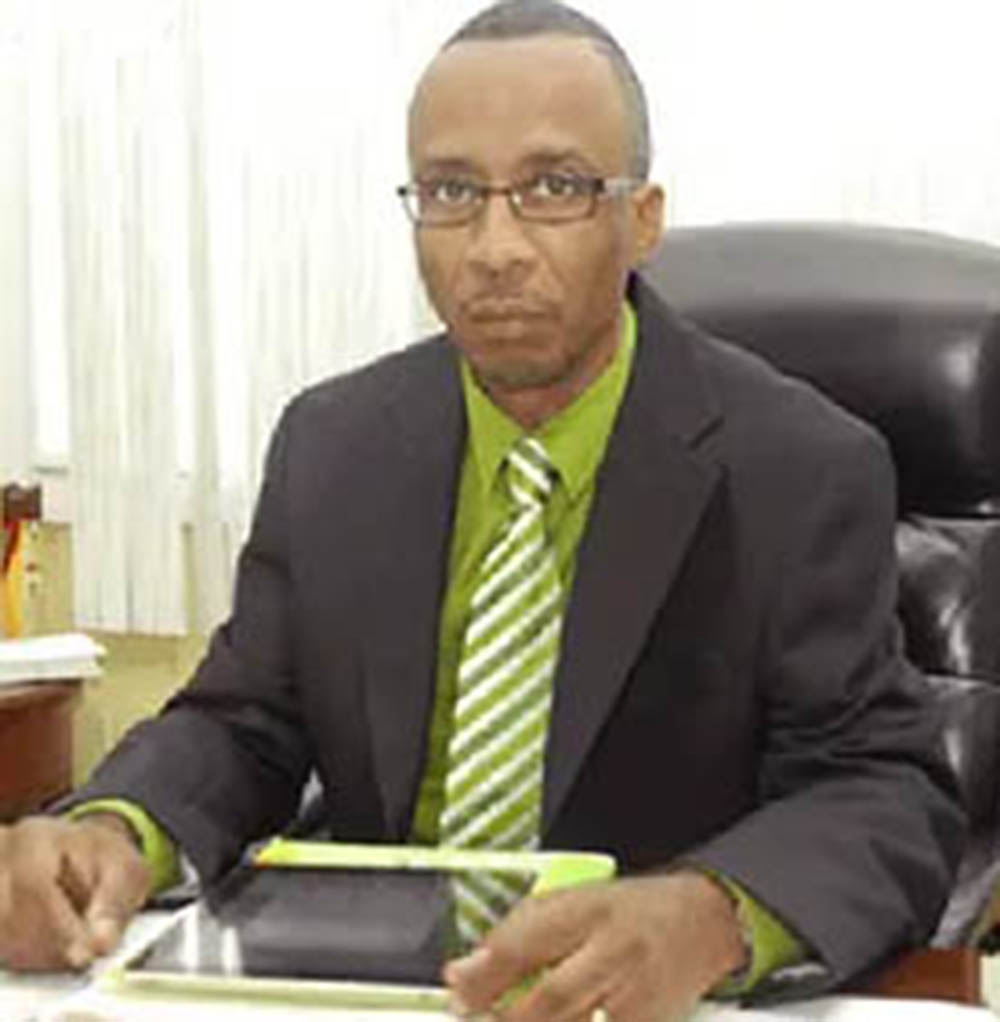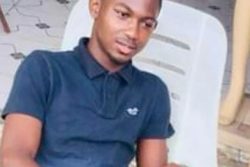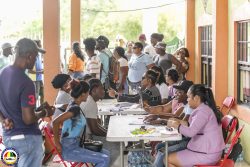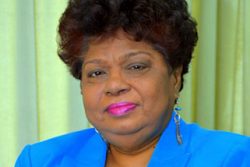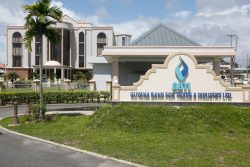It is now six years since former administrator Keith Burrowes kicked his addiction to painkillers; an affliction that changed his life, destroyed his family life, and damaged friendships as well as his reputation. His story is a cautionary tale for anyone considering using opioids, which are used medically to treat moderate to severe pain, but are highly addictive and commonly abused.
“Thank God I’m in a much better frame of mind, medically. Since 2017, I’ve been off addictive painkillers. I still have another surgery to undergo for the removal of a tumour,” Burrowes recently told Stabroek Weekend in an interview from Canada. “However, I don’t have to be back on the pain medication. If I were not so dedicated and committed to work and patriotic to my country, I wouldn’t have taken on all that responsibility and ended up with four back surgeries.
Burrowes revealed that his major health problems began when he was working at the then Guyana Agricultural and Industrial Development Bank (Gaibank) and he had “this habit of taking on additional responsibilities.”
While working in the accounts department he was elected secretary of the sports club. Initially, it was a dominoes club for managers only, but he was able to change that so all staff were eligible to be members. “I transformed that into one of the best sports clubs in Guyana,” he recalled. “I started the first inter-bank debating competition, the first inter-bank fashion show, and held evenings of classical music featuring Indian, African and Western classical music. I was very active and I was getting these terrible pains.”
In 1991, he went to Barbados for an exploratory laparotomy, a general surgery where the abdominal organs are examined for injury or disease. Nothing wrong was found.
“Before I went to Barbados I went to several doctors and was in several hospitals in Guyana, probably all, and was treated for gout, arthritis and other things. They had me on pethidine and all kinds of pain medication. Nothing in Guyana helped. We didn’t have CT scans or MRIs at that time,” he said.
Six months after Barbados, he travelled to the US, where a mass was found resting on a nerve in his spine. He had a major back surgery and was told he would have to live with some level of pain. “The doctor had me on OxyContin in the US,” he related. He came off the painkiller on his return to Guyana.
When the People’s Progressive Party/Civic government took office in 1992, Gaibank was merged with the Guyana National Cooperative Bank (GNCB).
“I was a member of the Gaibank board at the time and I had formed a welfare committee because I didn’t want to be the person going to the board. I had no problem with the merger. I had a problem with the staff getting their benefits,” he said. “We had some disagreements with government as to whether or not we should continue paying staff attending the University of Guyana (UG). The new institution was to take up all assets and liabilities. So when they said they were not going to pay for UG students, I threatened to call a press conference. The very afternoon the senior finance minister Asgar Ally asked me not to call the press conference and I did not. Then I had information that two prominent persons in the ministry wanted to reverse the severance package. I went to the senior finance minister one night and told him I heard the board had approved the reversal of the severance package. He gave me written correspondence that this was not the case. So when he was dismissed and one of the board members told me, ‘You not gonna get the severance pay,’ I showed him the letter from Ally and he almost got a heart attack.”
A lot of people, he said, criticised him for not migrating when others did. “I never told anyone what I went through to make sure we got the severance package,” he said. “This happened in May, the bank was merged in September 2005 and the government passed the severance pay package [bill] that standardised severance pay packages for public servants because of the package we were able to negotiate.”
Burrowes continued working at GNCB at the request of then finance minister Bharatt Jagdeo. “He told me he admired the way I represented the staff at Gaibank. From then on he placed me on several boards and the work became very much,” he stated. “I’m not complaining because I accepted but many times I was appointed to boards and I wasn’t consulted. I pushed myself. I was told not to push myself the way I did but I just wanted to make a contribution to my country.”
Sometime after he had been appointed a board member at Gaibank, he met a junior staff member who confided in him the problems she was having raising her grandchildren. He decided his board fees would go to a welfare fund to help staff members who had similar problems.
“I joined the bank in a junior position [in 1983] and even though my salary was small, $5,000, the board fees represented 35 per cent of my salary,” he said. “Gaibank was the lowest paid bank. From then on I never collected board fees on all the other boards I sat on.” Burrowes was on the board of directors of the Guyana Sugar Corporation, Guyana Office for Investment (Go-Invest), Guyana National Newspapers Limited among others. He also held several senior positions in government and received a lot of gifts, hundreds sometimes, at the end of the year, which he distributed among his staff, he said.
Start of addiction
Burrowes began to have problems when he was appointed to investigate a number of issues at the office of the Georgetown Mayor and City Council (M&CC).
“I am not going to blame the city council for my addiction,” he, however, said.
He recalled that he read in the newspapers that the government had appointed him to investigate some issues at the M&CC, before he had acquiesced to the request.
While at the M&CC, he said, he felt he could contribute to changing the work culture. He held hearings to find out what was going on, sometimes going late into the night. Burrowes had a special chair at his substantive office to massage his back to ease the pain, but could not take it with him to the city council’s chambers. Therefore, he had no support for his lower back, which needed it.
“It went on for a year. My intention was not just to investigate the few things that came up but to try to improve working conditions and also to provide a better service for the citizens of Georgetown,” he said.
He set up a committee to work along with him. “I was the sole investigator. I went beyond the normal call of duty to help the M&CC,” he stated. On a visit to the South Georgetown day care centre, he saw antiquated facilities being used in the kitchen to cook for children and started a basic nutrition programme funded by the Inter-American Development Bank (IDB).
“When I went to the city council I was managing, as executive director, several projects at the Health Sector Development Unit (HSDU), Ministry of Health. The nutrition programme was managed by me at the HSDU and it was probably the only programme the US health secretary recognised for the IDB in Guyana at the time,” he said.
While he was working with the City Council, his pain restarted. A doctor at the HSDU gave him an injection for pain, which Burrowes said he should have researched.
“My family was living in Canada. I had nobody to go home to so I worked whole day and whole night,” he said. “I didn’t know the injection was addictive. I should’ve known because I was working in the health sector. One night I couldn’t move in the chair. I had two back surgeries already.
“The pain was so intense and about one o’clock that morning, he gave me the injection and I was able to get up and move about. Then he gave me one [every day] for an entire week. When I started to feel better and stopped taking the medication, I started to experience withdrawal symptoms. That is worse than the pain. It was vomiting, diarrhoea, disillusionment. One night I attempted to jump through the window because the withdrawal symptoms were so bad. The only thing that helped with that was taking the pain medication again.”
Epidurals
Burrowes had previously worked with the World Health Organisation/Pan American Health Organization (WHO/PAHO) in Guyana between 2003 and 2007 and during which time he had his third back surgery.
Twice every year he went to the US for epidurals – a mixture of steroid and numbing medicine injected into the affected area. After he left WHO/PAHO and was assigned to the HDSU, Burrowes said, Jagdeo asked him to take over the debt recovery agency that was operating within the GNCB.
“I said, I will do it but I needed to get the epidurals. The government supported that. However, the epidurals were administered on the spine and the doctors advised me they were eroding the vertebrates. They wanted to ease off the epidurals and I stopped taking them,” he said.
While he was with the debt recovery agency, Burrowes said, Jagdeo called him again and told him he wanted him to go to the HSDU. Burrowes said he was not keen on going because he was recovering loans at which others had failed. He recommended several people, but Jagdeo insisted he wanted him.
“My addiction didn’t start from the time I went to the HSDU when I was still getting epidurals,” he stated. “My addiction started when I stopped the epidurals during the latter part of my tenure with the HSDU when I had successfully implemented most of the projects I was tasked to complete and I started the intensive work with the M&CC. I want to make it clear, even though I knew of my medical situation, if the government asked me to do something, that is who I am, I would say yes to it.”
When the addiction worsened, Burrowes went to a number of private facilities in Canada. “I thought I was okay after spending a couple of weeks and returning home,” he said. “Restarting my routine, the pain restarted.”
Jagdeo and Dr Roger Luncheon, who he considered his second father, told him they were sending him away for a year to recuperate. “I went and I came back in three months. I thought I was okay,” he said.
On his return he was asked to take over the Guyana Office for Investment (Go-Invest). “Go-Invest has smeared my reputation significantly,” he said. “I don’t blame anybody. I blame myself. When I was asked to go to Go-Invest I didn’t want to go. They said it was just for six months.
“My addiction to painkillers was really bad at that time. I tried to do what I could do in the interest of staff. I knew I would not have been there for long. There were staff who had children who had nowhere to stay when they came from school. I set up a room for when they came. The drivers had no access to computers in their room and I put some for them so everyone would have access to the internet. I modernised the building and did a lot of structural work on it.
“I put systems in place to monitor investors. There was so much I could do and no more at Go-Invest. When the auditors did their work at Go-Invest they did not mention the positive things they only mentioned the negatives.”
He said allegations were made against him and the reason why his response was not made public was because of a gentleman’s agreement he had with the new trade minister Dominic Gaskin to keep Go-Invest out of the limelight.
“Even though Kaieteur News published a ridiculous report, and I could not get a job afterwards because of it, I stood with the gentleman’s agreement,” he said.
His addiction was harrowing during the period he was at Go-Invest. “I was asked to stay for six months and they extended it for another six months,” he recalled. “To be honest, I think the change in administration might have saved my life.”
He said because of his addiction, he shut people out; he did not want them to see the state within which he was operating. “You lie to people who care about you when they ask if you are using any medication,” he noted “I never used medication to get a high, I used it for pain and then to make me sleep.”
He said addiction changes the way the brain operates and some of those changes cannot be reversed. Counselling may help the recovering addict to live in a new dispensation, because some of it is reversible.
“That is one of the things with addiction, you have to accept that you need help. I was almost on death’s bed when I recognised I had to get help and take responsibility,” he said.
Burrowes was treated for his addiction at the Centre for Addiction and Mental Health (CAMH) in Canada, 12 years after he first applied. “When I finally got into CAMH, it was a holistic approach and I was able to deal with it,” he said “I had [another] surgery to deal with the pain. I don’t have to be on pain medication. In fact, I don’t even like using normal over-the-counter painkillers. I only use it if I really have to.”
Addiction for him, he said, created its own kind of problems. “The enablers who provide you with the medication know how bad the withdrawal symptoms are, so if a vial is $5, they price it 1,000 times that. I cannot begin to tell you how much money I spent on that,” he said.
“So, it puts you in another position where you start making decisions of borrowing, or, of getting into activities that could even border on illegality. Fortunately, I was able to keep myself away from those vices because I had a lot of people who supported me and my addiction. Sometimes I paid $10,000 for one vial just because they knew the withdrawal symptoms were so bad, that I would have done anything to get it. It destroyed my family life and my relationships with friends. It destroyed my reputation in Guyana.”
